|
|
| Разместил (Author): |
SergUA6  |
| Авторские права |
© http://www.radioscanner.ru |
|
|
Текст
|
SA: work with OFDM module, FFT spectrum.
Let's consider new abilities of SA OFDM module in version 6.1.0.3
In the description of the previous version and in the first part of OFDM module tutorial, we have mentioned "the magic triangle", and have defined, that detection of this triangle says, that the analyzed signal belongs to OFDM class with CP. We have also concerned the bases of OFDM creation principles, and we had also have defined, that the triangle is closely linked with the transferred OFDM symbol. Let's go further, let's take a view on the triangle more attentively.
For start, we will consider schematically structure of the magic triangle, and we will try to understand, why only triangle shape is the right sign, and what is so good in it? As I was already spoken, the magic triangle - it is known result of correlation of two equal rectangles, but nevertheless, we will look hardly more deeply on this triangle. Here is seven(conditional) main steps of results of calculation of correlation, we assume that LS and LG are received precisely:
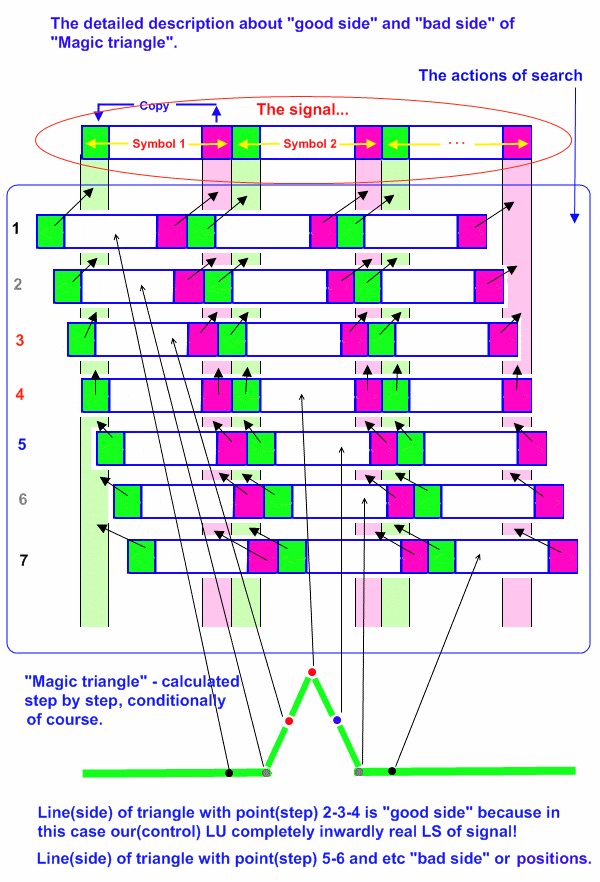
It is perfectly visible, that the triangle's peak precisely points on an absolute coincidence of the control LS and LS of the signal. So It is perfectly visible that the triangle left-hand side "tells" us: that LU of the control window LS, has completely entered into LS of the signal(It is very important moment). Increasing of the amplitudes (rising) of the left-hand side of the triangle shows that: the control LU is closer and closer to it's "native position" in LS.
Right side of the triangle says that: the control LU, does not get any more completely in the signal's LS, and it goes away further and further, thereupon the right side becomes not valuable for the analysis. It is important to to understand, why the left side is good for analysis , and right is not good. We do not want, user thoughtlessly place the marker on "the good side", without understanding why it should be so and what is hidden behind it.
Ок, let's look on CP (LG), what does CP give?
CP increases length of the symbol, on such number of countings, which is left for CP. What in general it means?
As CP it is a copy of a part of the end of OFDM symbol, CP possesses the very important property: it is ”fastened" in the beginning of the symbol precisely in the phase. Here follows an awesome conclusion: The quantity of correct LU values is not just one in the symbol with CP!
Quantity of the correct LU = LG+1.
More visually it looks so:
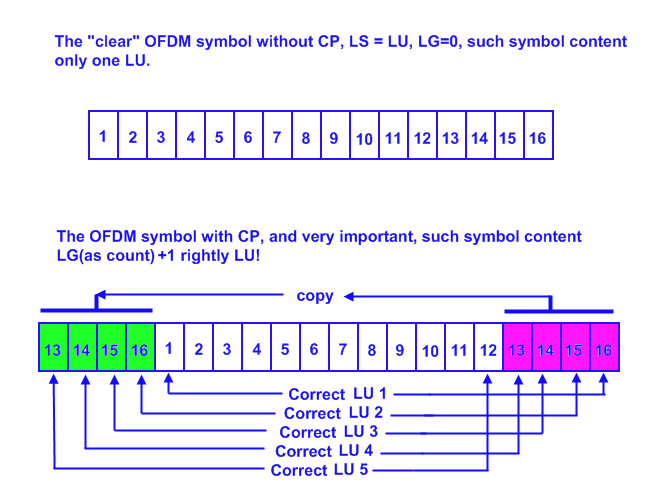
It allows us to use LU freely enough at the analysis, because any LU, which we receive on "the good" side of the triangle, is basically correct.
Let's move to practice now. I will only mark that, in case of getting quantity of channels and their amplitudes, all LU are equal. We will check up everything, as well as it is necessary, on an ideal signal. Let's synthesize, for example, such test signal .
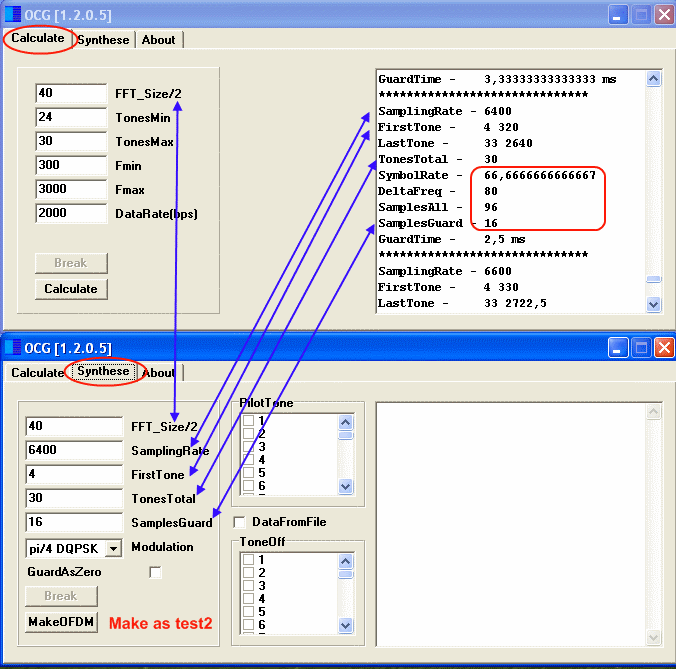
Everything, what has been told earlier, is approved.
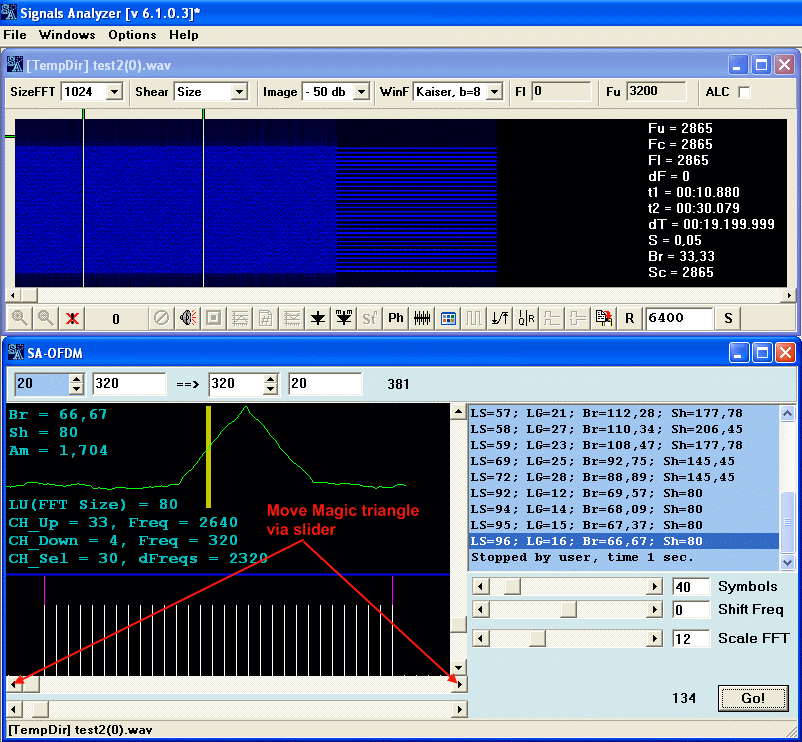
Move the specified slider and be convinced that "the good side" is really good, and that it's length takes precisely LG size, and that on this side all channels, which are entering into LU have stable amplitude and location.
Certainly you will notice that the real signals, behave a bit differently, than an ideal ones, but you will also notice that the negative triangle does not promise anything good, and that it is useless to search for anything on "the bad side of triangle", because there is simply nothing to search for. You will see, that, in general, all OFDM signals with CP submit to the common laws, considered by us earlier. Thus, as soon as the marker leaves "the good side", FFT spectrum starts to behave strange, unpredictable and etc.
Let's consider some practical nuances:
Please Pay attention, on the field LU (FFT Size) = X, where is X - is FFT block size, or the size of LU in samples. On real signals, X can be any. Actually, only the even size can be considered as the correct. Odd size of LU says that, the sampling rate, or signal's shift by frequency, or all that have together led to the fact, that LU is precisely lay down on the odd quantity of countings of the sampling rate. It is not forbidden, but it is not correct. Although, even in this case, SA program works, bacause we use FFT algorithm working with any quantity of samples.
Why the yellow marker sometimes is a one pixel thick, and sometimes it is rather wide bar? Here all is very simple:
The size of LS is not limited, formally, there can be signals both with LS=20 and with LS=2000, and for more comfortable observation of "the magic triangle", the map is scaled, and sometimes, there are 20-30 or more of countings in a one pixel, in this case, the marker is a thin line, and sometimes one counting is expanded on several pixels, and then the marker is wide.
You can consider the results of spacing and speed of manipulation as correct or atleast very close to real ones only in case when:
1 - your triangle is motionless at symbol-by-symbol moving,
2 - LU is even,
3 - peak is positive
Otherwise it is necessary to speak about conditional enough accuracy.
Actually, you will notice that OFDM signals, allow rough enough inaccuracies. The very good spectra can be seen even at the big errors, moreover, it is also possible to receive the quite good constellations in the channels at not small errors, but it concerns only to relative sorts of manipulation. The absolute constellations in channels, such as QAM, demand very serious measures of bringing on parameters of a signal to true ones. But this is already the future...for now I suggest to be mastered with this tool SA OFDM module, this tool allows to do very many things, for example, like this:
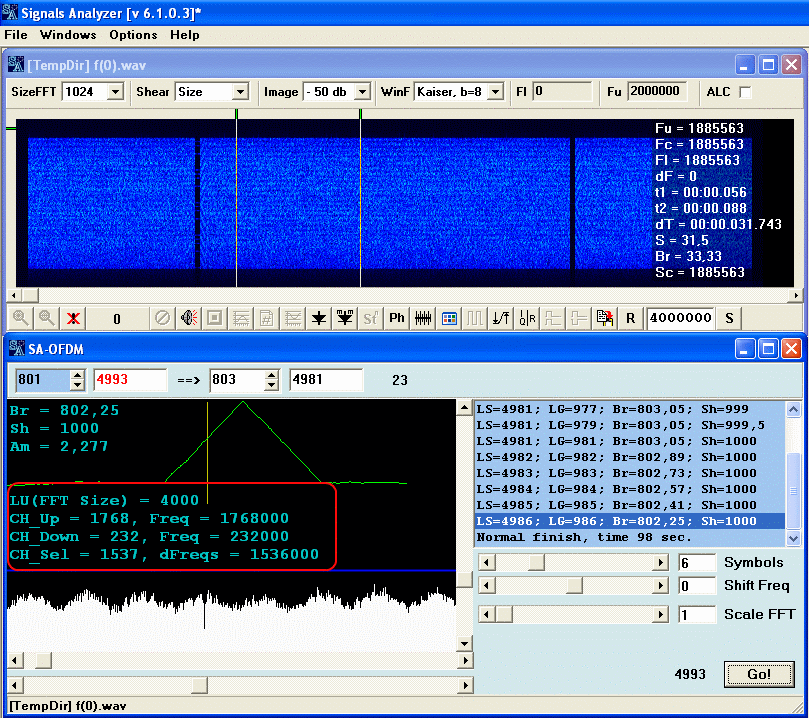
It is DAB signal. FFT spectrum of this signal do not fit into the mapping window of the module on my screen monitor:) You do not have chances to receive exact precise parameters of this signal by any other way. SA allows to get precise parameters.
Good luck~
|
|
|
|
Добавлять комментарии могут только зарегистрированные, активировавшие регистрацию и не ограниченные в доступе участники сайта!
|
| Файл создан: 04 Nov 2009 14:14, посл. исправление: 04 Nov 2009 19:20 |
|

